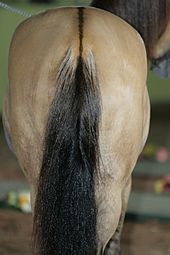Primitive markings
[2] All dun horses possess at least the dorsal stripe,[1][2][3] but the presence of the other primitive markings varies.
[1][4] Primitive markings in horses are an example of atavism: preservation of or reversion to ancestral type.
[1][5] Of equids other than horses, all except the mountain zebra show a distinct dorsal stripe.
In Przewalski's horse, the dorsal stripe is usually dark brown, while it is black in the bred-back tarpan.
Dorsal stripes on dun horses with the cream gene seem unaffected by cream: smoky black-duns ("smoky grullas"), buckskin-duns ("dunskins"), and palomino-duns ("dunalinos") have black, brown, or red dorsal stripes, as well.
[1] Leg bars are most commonly seen on or above the knees and hocks, and reflect the underlying coat color.
[7] Leg bars are prominent on Grevy's zebras and mountain zebras, and African wild asses also have well-defined black leg bars below the forearm and gaskin on a white or pale background.
[1] One classical genetics study concluded that stripes on the front legs seem to follow an autosomal dominant mode of inheritance.
[9] Indistinct or poorly defined markings in these regions are often called neck or shoulder smudges, patches, or shadows.
[7] Such characteristics are very visible among the Fjord horses, which have their sandwich-patterned manes shaved short and upright.
[4] Primitive markings on non-duns can be seasonal, visible only when the horse is shedding its coat.








